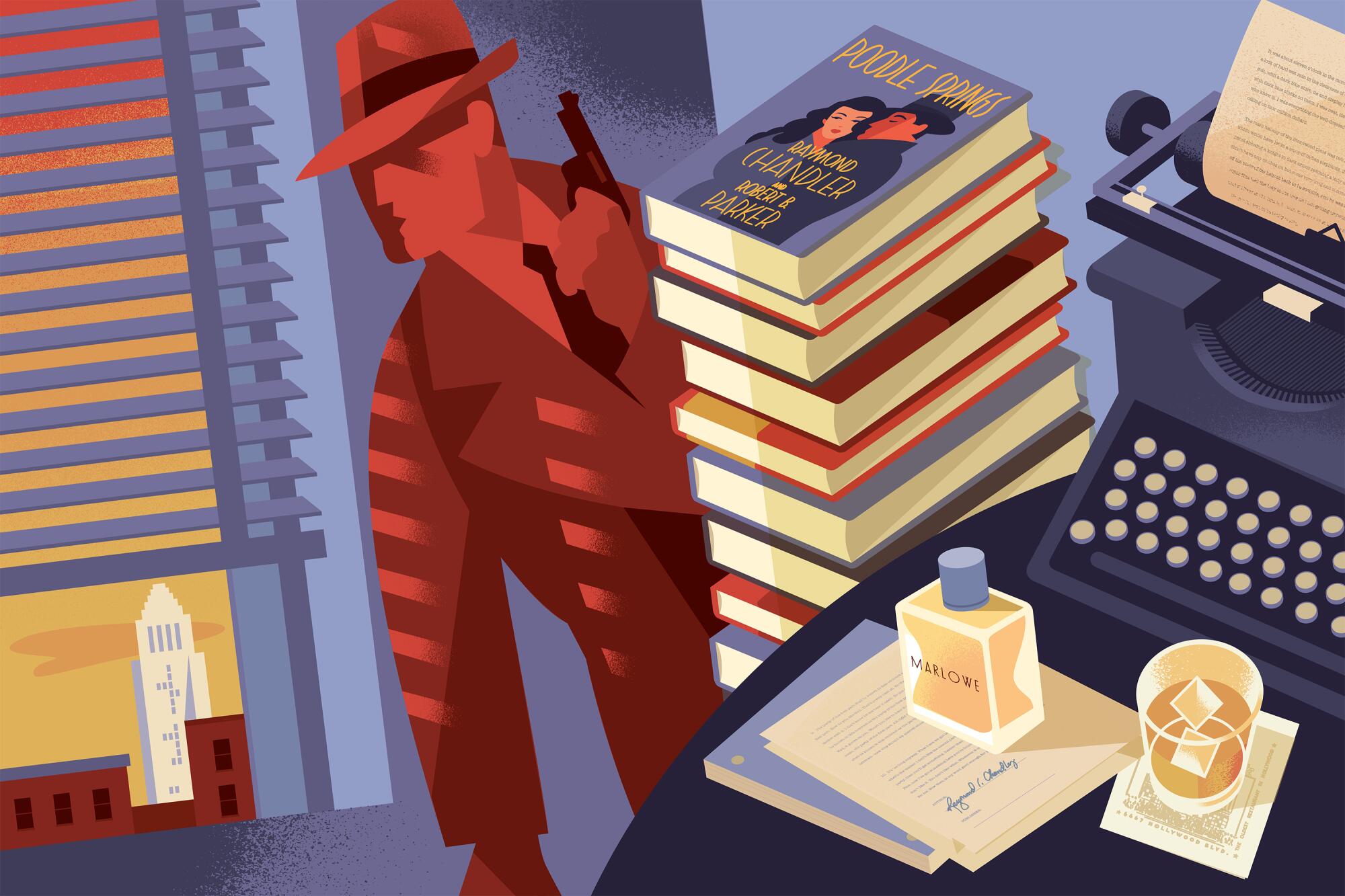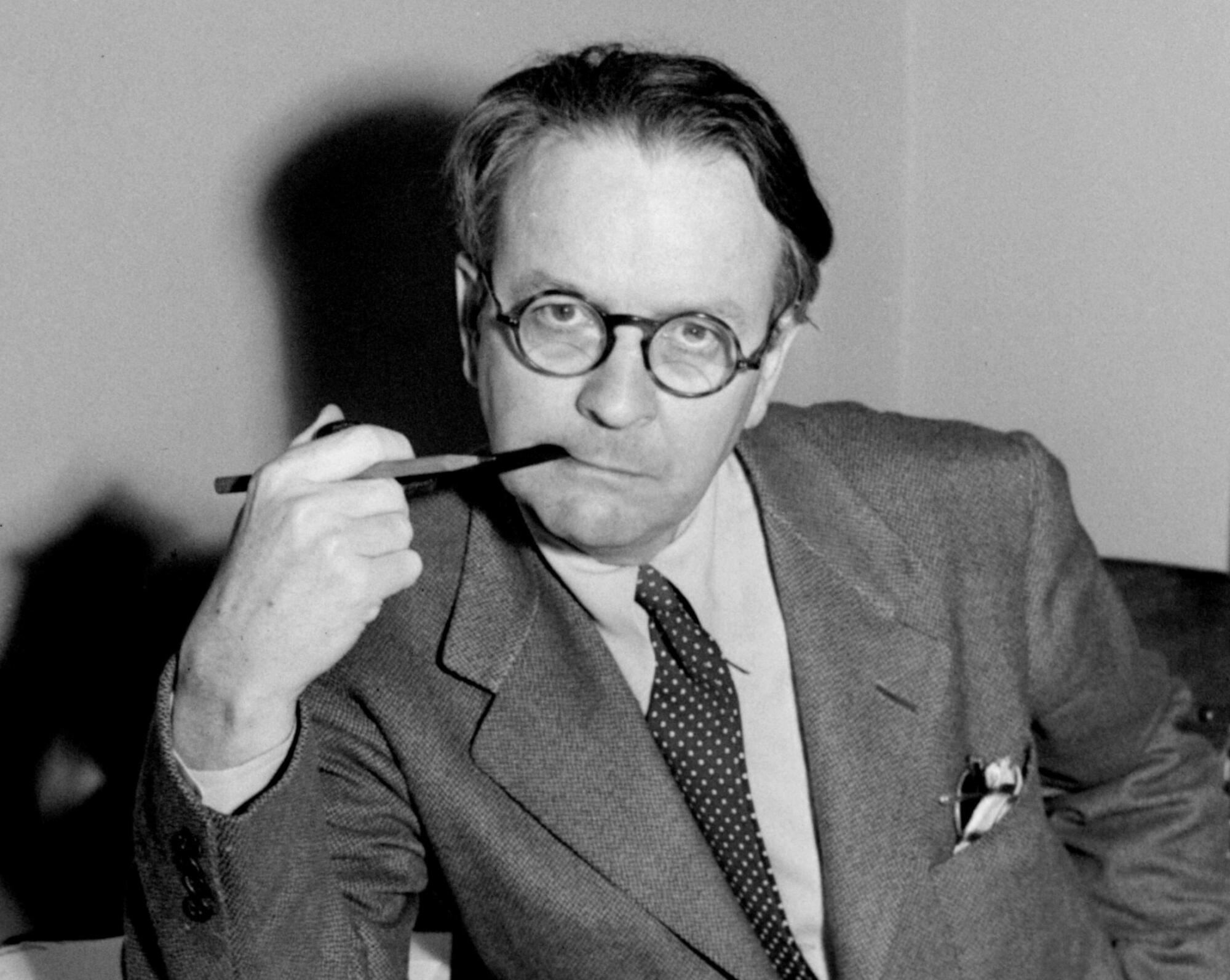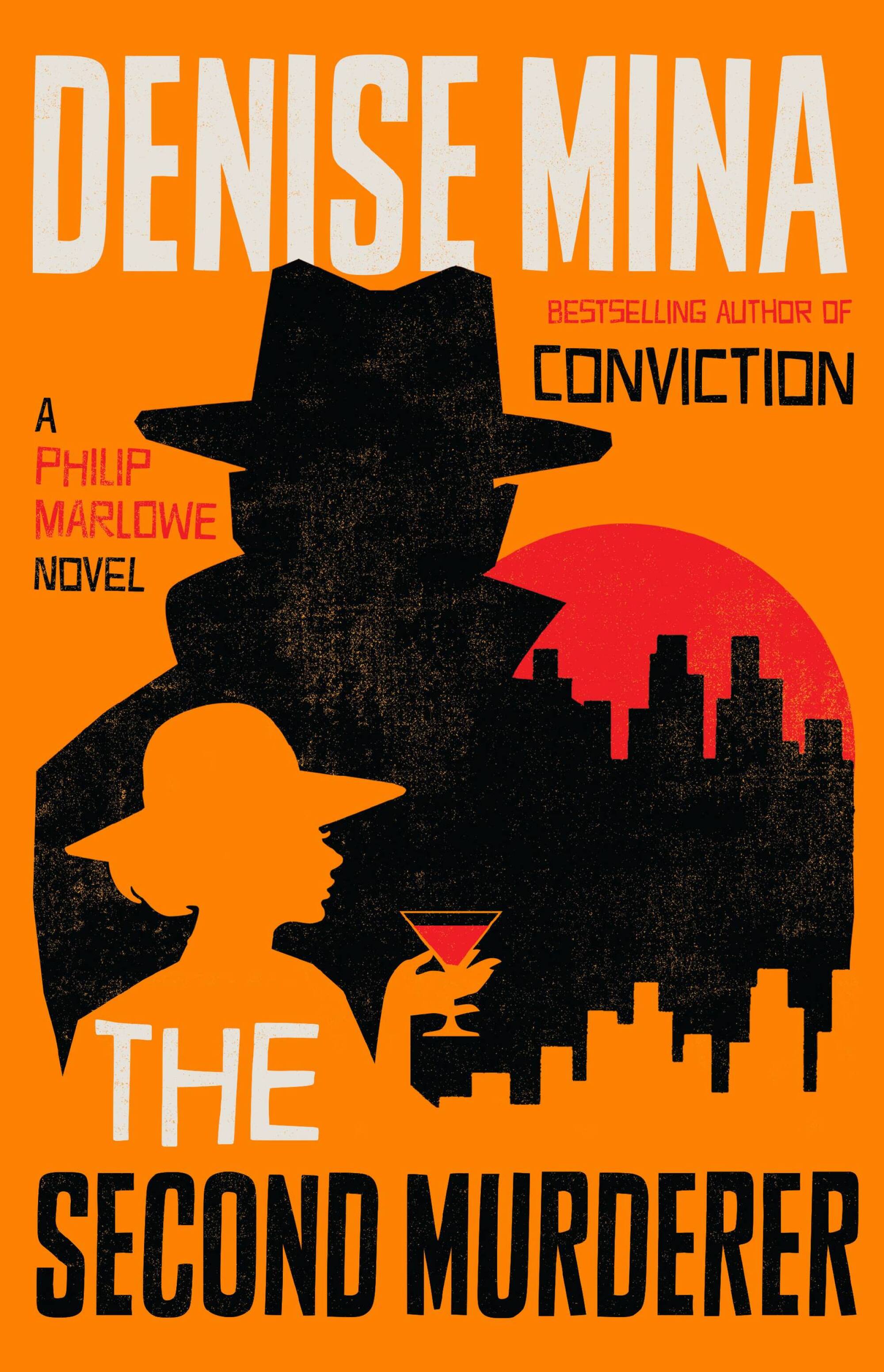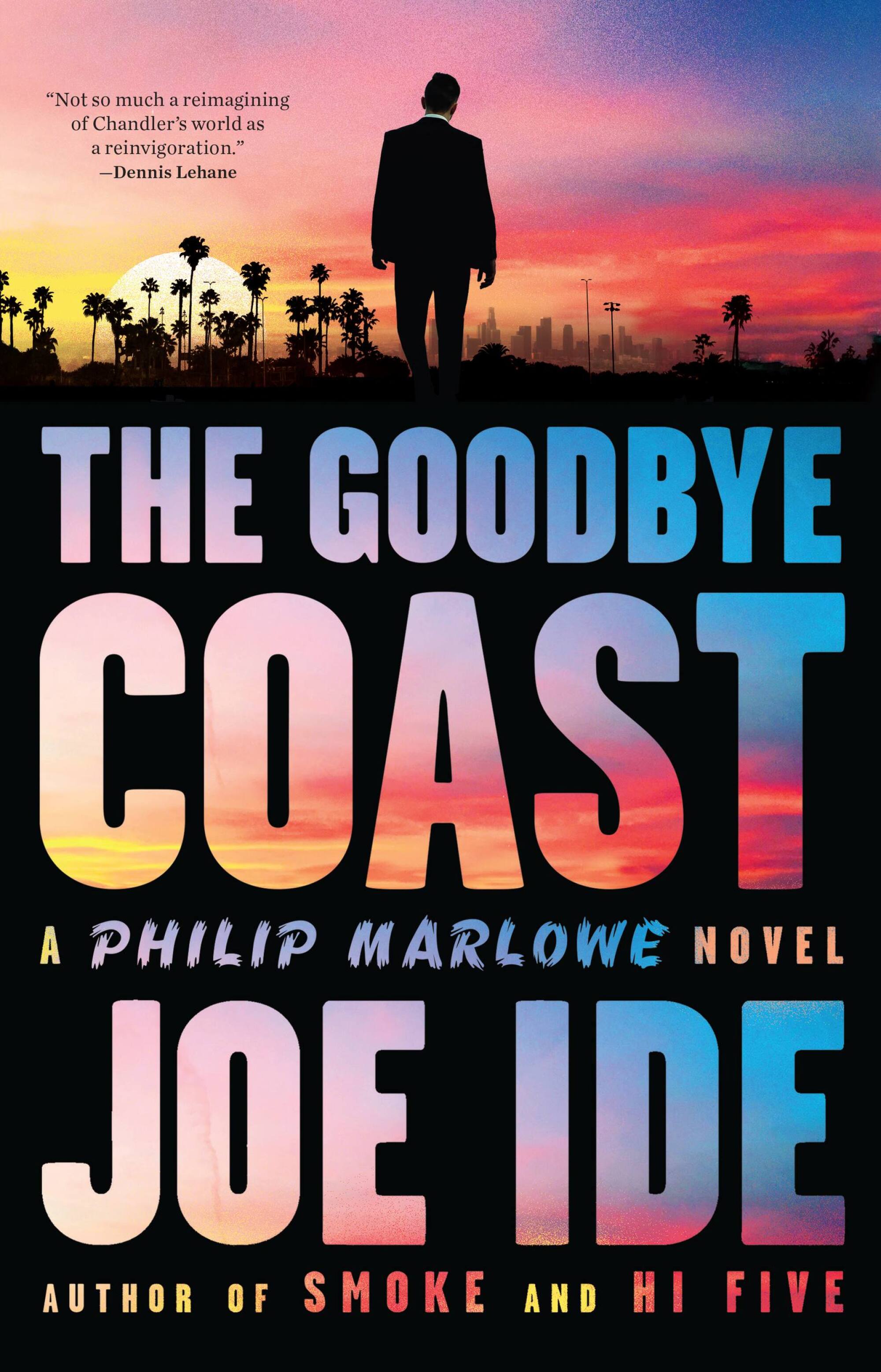
Like a private eye sizing up the details of a dicey new case, Joe Ide took the call from the Raymond Chandler Estate with a healthy amount of hesitation. “I was thrilled at first, as any crime writer would be,” Ide said. “And then I got frightened.”
Ide, the author of the neo-noir series “IQ,” was being asked to write an original novel using Chandler’s iconic detective, Philip Marlowe. But unlike Chandler’s Marlowe, who for many defined the hard-boiled mystery genre in classics including 1939’s “The Big Sleep” and 1953’s “The Long Goodbye,” Ide’s Marlowe was to exist in the present day.
“What is a contemporary Marlowe?” Ide recalled wondering, speaking over video call from his home in Santa Monica. “I couldn’t just take Humphrey Bogart and put him in a Tesla.”
In “The Goodbye Coast,” which came out in 2022, Ide eventually opted for a more modest 2008 Mustang GT as the vehicle of choice for his Marlowe, who prefers to wear a suit, sure, but also knows how to use GPS; who drinks and smokes, yes, but a lot less than in “The High Window.” It’s a literary thought experiment committed to paper; in addition to the time warp, it’s also written in the third person, unlike Chandler’s standard first person. For those with a strong attachment to the original Marlowe, the result is almost psychedelic.
If Ide’s treatment isn’t up your alley, there are plenty of other Marlowes to choose from. The Chandler Estate first licensed a new Marlowe novel in 1989 by hiring Robert B. Parker to complete “Poodle Springs” — unfinished at the time of Chandler’s death, in 1959, at age 70. Parker wrote one additional Marlowe book in 1991, but the revival series went quiet until 2014, when Booker Prize–winning novelist John Banville published “The Black-Eyed Blonde” under the pen name Benjamin Black.

Since then, with a new caretaker in charge of the estate, there’s been a steady clip of “Philip Marlowe Novels”: “Only to Sleep” in 2018 by Lawrence Osborne, “The Goodbye Coast” in 2022 and “The Second Murderer” last year by Denise Mina. These releases are something of a warning shot for a new, more aggressive phase of Chandler commodification that may soon make the posthumous sequels (hardly a rarity among literary estates) seem quaint. If zombie Marlowe novels make you queasy, you might not be ready for the extended Chandler universe that’s on the table. But for the latest iteration of L.A.’s most enduring literary brand, the sky’s the limit.
Chandler created a world of characters rich enough for other writers to harvest for generations to come, but he never had children of his own. The work of managing his estate instead ended up in the hands of Helga Greene, a publishing figure from a powerful family. (Author Graham Greene was her brother-in-law from her first marriage, to Hugh Greene, the one-time director-general of the BBC.) Helga came into the picture after Chandler’s wife, Cissy, died in 1954 and Chandler had fallen into a dark final chapter, struggling with loneliness and alcoholism, at one point attempting suicide.
Several women, Helga among them, moved through Chandler’s life during these years, when he passed around engagements and will codicils like party favors. After his death, there was a brief legal dispute over the estate between Helga and Jean Fracasse, Chandler’s secretary, but Helga, whom Chandler had proposed to just before his death, prevailed. She eventually passed the estate on to her son, publishing magnate Graham C. Greene, who worked with literary agent Ed Victor. After Graham C. Greene and Victor died, in 2016 and 2017, respectively, the role of estate director was passed to Alexander Greene, Graham’s son, who wasted no time commissioning new novels and pursuing other media, from graphic novels to television.
“There’s a risk with any estate for books to become lost in time,” Alexander Greene said on a video call from Switzerland.
Raised between London and Tuscany, Greene, 45, is a somewhat unlikely steward of a hard-boiled California world. Bespectacled, soft-spoken and a little mischievously quizzical — just as likely to ask you a question in response to your own — he could very well be a mysterious figure in a Chandler book. His family owns a literal castle in Tuscany, and he noted that Helga, who died in 1985, once lived in a brutalist home that was “quite Bond villain–like in some ways.” “I think my role,” he told me, “and that of my father and my grandmother before me, was to try to make sure that Chandler’s works are valued in the right way.”

In some sense, the estate has never topped the first major Chandler film project. Only a few years after “The Big Sleep” was written, Howard Hawks directed a version of it — released in 1946 — starring Humphrey Bogart and Lauren Bacall, with William Faulkner serving as one of the screenwriters. Since then, there have been a variety of film, television and radio Marlowe programs, with just as much a variety of success. There are beloved creations, like Robert Altman’s 1973 film version of “The Long Goodbye” with Elliott Gould, and forgotten ones, like Bob Rafelson’s 1998 television film version of “Poodle Springs” with James Caan.
“One never quite knows what the outcome is going to be,” Greene said of outside collaborations. “Particularly when what you’re doing is investing effort and time with highly creative people. And sometimes they have hits and sometimes they have misses, and you just hope that you get more of the hits than the misses. It’s super difficult.”
That challenge was apparent with the most recent movie project, “Marlowe,” the first Chandler feature film to come out in more than 40 years. Directed by Neil Jordan, starring Liam Neeson and based on Banville’s “The Black-Eyed Blonde,” “Marlowe” was beaten to a pulp by critics almost as badly as Neeson is in the picture. Greene sees it as a demonstration of how “complicated it is to make a really great noir film in the contemporary setting.”
“I think it was a great team, and I really enjoyed the film, actually,” he said. “But commercially, it has not been a huge success.”

Mina is a little more candid about the criticisms of her Marlowe novel, “The Second Murderer” — the first in the series written by a woman — over video call from her home in Glasgow. “It pissed quite a lot of people off, you know,” she said.
Mina is spunky and wisecracking — “I’m kind of like a McDonald’s franchise in Arkansas,” she said of her arrangement with the Chandler Estate — and she seems to take some pride in pissing people off. Before “The Second Murderer,” she had tackled other beloved franchises, writing graphic novel stories for both “Hellblazer” and “The Girl With the Dragon Tattoo.”
Although some critics are apt to complain that any new Marlowe books are objectionable, Mina also faced detractors specifically against the idea of a non-Angeleno in the driver’s seat. “L.A. is to Chandler what blood is to our bodies,” said Judith Freeman, a novelist who wrote a biography of Chandler, 2008’s “The Long Embrace. “[The city is] inseparable from the action and the characters so deeply embedded in his fiction.”
Mina readily admitted that she “really shouldn’t have written” her Marlowe book, “because I’m Scottish and just a fan.” But her story is set in an L.A. that doesn’t exist anymore (if it ever existed). “I was doing so much research, and thought, actually, ‘It’s probably great being this far away,’” she said, noting that a planned research trip was ultimately scrapped due to the pandemic. “Because [Chandler’s] L.A. is the idea of L.A. rather than actual L.A.”
“The Second Murderer” centers on another archetypal Chandler scenario: a dying oil tycoon hires Marlowe to find his missing daughter. But Mina adds an adventurous touch, choosing to explore the figure of Anne Riordan, a former police chief’s daughter who stands out as not just another femme fatale or “blonde to make a bishop kick a hole in a stained glass window,” as Chandler describes a character in “Farewell, My Lovely.”
Mina also wrote a tongue-in-cheek subplot involving the inner workings of an artistic estate — her way of nodding at the ambitious one of which she became a hired hand. “I’m so interested in the notion of intellectual property and the idea of an estate being a thing that can be owned and nurtured,” she said with a smirk.
When it comes to the broader work of owning and nurturing the Chandler Estate, Greene doesn’t feel that his day-to-day is all that different from his grandmother’s and father’s: License out projects, tinker with book covers, etc. But there are some distinctions. “Obviously,” he said, bringing one of these up, “there’s an enormous amount of sensitivity surrounding — I think rightly so — racist, misogynist and antisemitic characters in works of that period,” he said.
The debate over what to do with vile language and attitudes in old classics is as polarizing as any culture-war issue — especially in light of the recent decision to bowdlerize Roald Dahl.
Greene, anyway, believes that Chandler comes out decently well, in the sense that the antagonists in his books are usually the least tolerant individuals in the stories. Nonetheless, a clear objective with hiring writers like Mina and Ide is to allow them to write versions of Marlowe more palatable to certain modern readers. In “The Goodbye Coast,” for instance, Marlowe is worldly and has an affinity for foreign cuisine; in “The Second Murderer,” he deftly follows his case into the underground gay scene of 1940s Los Angeles.

“Do you know what I was amazed about is how many subcultures and worlds in L.A. that [Chandler] didn’t represent,” said Mina. “And there was so much happening in L.A. at that time, structurally, civically — things that I think would actually have really interested him.”
But the most difficult trick of bringing Marlowe to the present day has nothing to do with the present; it lies instead in matching Chandler’s masterful balance of pulp readability and literary sensibility. (Chandler, after all, was a semi-private poet his entire life; a poem from around 1955 was recently published in the Strand Magazine.) His witty similes and graceful prose have arguably done more to open minds to the potential intellectual value of crime fiction than any other writing.
The ultimate question, perhaps, is what Chandler would have thought of authors cosplaying as him. In several decades of work as a novelist, he produced only seven Marlowe books in large part because of his dedication to details of the craft. But at the same time, no one knew better than Chandler, who began writing crime fiction to pay the bills, that the genre exists to be a blast to read, above all other considerations.
“I’m trying to take [Chandler’s] books and move them,” Ide said of his mentality of the project. “And it’s a commercial enterprise. I had to keep that in mind.”
One answer to the riddle might be found in Chandler’s 1944 essay on crime fiction, “The Simple Art of Murder.” “There are no vital and significant forms of art,” he wrote, “there is only art, and precious little of that.” Read anything you come across with an open mind, he seemed to be saying, and follow the trail of worthwhile material for yourself.
Your ultimate L.A. Bookhelf is here — a guide to the 110 essential L.A. books, plus essays, supporting quotes and a ranked list of the best of the best.
Kim Cooper, a Chandler historian whose L.A. group, Esotouric, offers a guided tour focused on the author, has been following the estate’s trail for decades and is one of its more vocal critics.
In 2014, the estate blocked Cooper’s attempt to develop a show out of a lost comic opera by Chandler, which Cooper had discovered. Staying on the Greenes’ toes, she co-wrote a review of “The Second Murderer” last year that cited issues with geography and other local trivia. “It is plain that nobody who knows anything about the city read this novel before publication,” the review sighed.
But Cooper, despite all her apprehensions, doesn’t take broad issue with the idea of hiring outside writers, or of any other reasonable new project. Her main concern is that the original material might get lost in the fray — that Chandler’s Marlowe becomes just Marlowe. “I would really like to see there be a renewed interest in what Chandler actually produced,” she said, “because I feel like Chandler’s work needs to stand separate from whatever new interpretations are happening. I’d like to see some energy into that.”
How the original Marlowe novels are handled is a matter to be watched closely, given that Chandler’s writing will begin to enter the public domain as the copyright expires in the coming years. (U.S. copyright for works before 1978 is generally protected for 95 years; “The Big Sleep,” for instance, will be up in 2034.) The ticking timeline could offer some window into the decision to accelerate production of legacy Marlowe content. But Greene insisted that the calendar isn’t dictating his approach to the estate. “In the U.S.,” he wrote in an email, “we have good protections in trademarks for Philip Marlowe and we will continue to generate interesting new projects going forward.”
Each new book is a potential new movie, he pointed out, adding that a television project with Bad Robot Productions is in the works, as well as a graphic novel by Arvind Ethan David. And besides, there are other potential destinations for the IP, he adds: escape rooms, video games, perfume.
Just what would a Marlowe scent smell like? “Something with a little bit of gun smoke, a bit of leather,” he said with a laugh. “A bit of fedora hat, a bit of beaver skin. Perhaps a little bit of whiskey.”
Greene mentioned that at one point, he had been shown a document drawn up by Walt Disney as a guide for what the broader Disney empire would look like, and that he thought of this document often. He’s not trying to make a Chandlerland theme park, but the question remained: “What do I do to fit all those pieces in?”
In Disney’s illustration, from 1967, there are dozens of arrows swirling around the page, pointing to various categories like TV, music and merchandise; everything feeds back to the studio at the center. “It’s about delving into the different parts of the world in different ways and filling them out as much as possible,” Greene said. “Without creating a cinematic universe. Because that would be just awful.”
More to Read
Sign up for our Book Club newsletter
Get the latest news, events and more from the Los Angeles Times Book Club, and help us get L.A. reading and talking.
You may occasionally receive promotional content from the Los Angeles Times.








